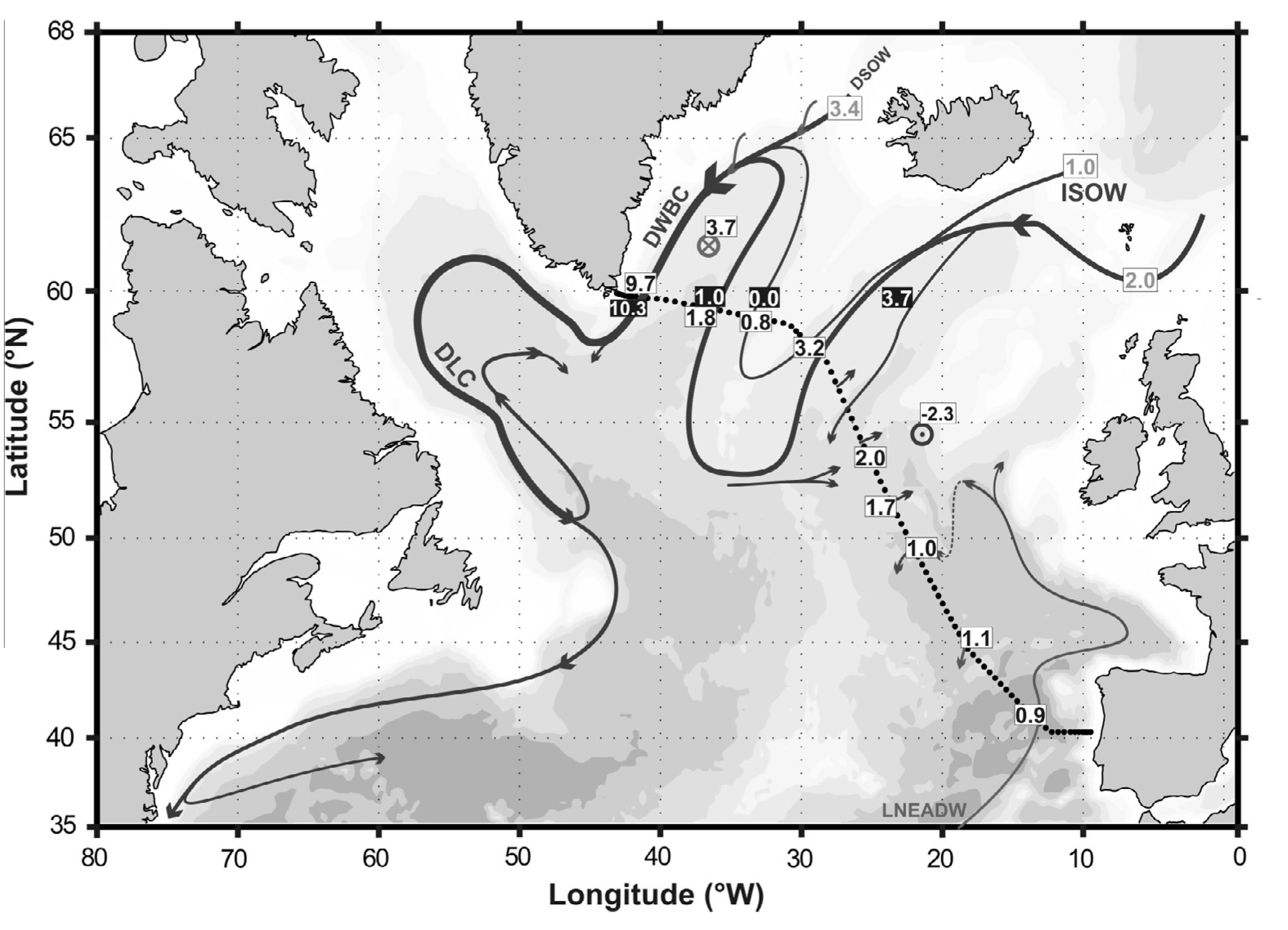by Amy bower
While the rest of the OSNAP team has been busy preparing the first continuous time series of the AMOC in the high-latitude North Atlantic from the OSNAP array measurements (link to Science paper), the Bower Lab has been steadily processing data from more than 120 deep-sea floats that were released in the deep currents of the AMOC between 2014 and 2017 as part of “OSNAP Floats”. These so-called RAFOS floats (RAFOS stands for RAnging and Fixing Of Sound) were tracked continuously underwater using an array of 13 moored sound beacons spread throughout the subpolar region. Once a day during each float’s mission, the float “listened” for signals from the sound beacons, and internally recorded the time it heard each one (usually only 2-4 beacons were in range on any given day). After two years of collecting these “times-of-arrival” from the sound beacons, each float dropped a ballast weight, popped to the surface and transmitted all its stored data via satellite. We have been reconstructing each float trajectory by converting the acoustic travel times to distances, and triangulating float position for every day. It is always an exciting moment when the complete trajectory pops onto the computer screen, usually revealing some incredibly interesting pattern of the flow deep in the ocean.
Nearly every diagram of the pathways of the lower limb of the AMOC in the subpolar North Atlantic show continuous lines of flow snaking around the rim of its three sub-basins: the Labrador, Irminger and Iceland Basins (e.g., Fig. 1). This view of the deep circulation has been shaped largely by our observations of the subpolar ocean around its edges, which almost all show a relatively strong deep boundary current transporting modified versions of the dense overflows (Iceland-Scotland Overflow Water and Denmark Strait Overflow Water) that feed the lower limb of the AMOC. When we track the pathways of individual fluid parcels, or large groups of them, we see a somewhat different view of the pathways of the deep AMOC (Fig. 2). This “Lagrangian” view—by which we mean the ocean circulation as observed by following individual fluid parcels, in contrast to the “Eulerian” view, which is constructed from current measurements at fixed locations—highlights the turbulent nature of the currents in some regions of the deep ocean. The float trajectories show a much messier view because deep ocean currents are not always orderly streams of water flowing smoothly along, but rather consist of blobs or patches of water 10-100 km in diameter swirling around like slow-motion hurricanes.
In some regions, the Lagrangian and Eulerian views look similar, at least on the large scale. For example, most (but not all) of the floats released east of Greenland more or less follow the boundary around the southern tip of Greenland. In other regions, however, the boundary-following pipe-like view seems completely inadequate to describe the deep pathways of the AMOC. For example, floats coming through the Charlie-Gibbs Fracture Zone (a deep gap in the mid-Atlantic ridge that separates the Iceland and Irminger Basins) do not, in general, follow the boundary of the Irminger Basin. Instead, the floats spread westward and even southward in a somewhat chaotic fashion. Also, some floats released in the deep boundary current transporting Iceland-Scotland Overflow Water southward in the Iceland Basin never make it to the Irminger Basin through gaps in the ridge, but instead drift southward within the eastern North Atlantic, apparently having escaped from the deep boundary current system altogether.
So why do we care what pathways these deep waters take? For one practical reason—if we want to accurately monitor the strength of the deep AMOC, we better have a good idea where its major branches are so we can place our instruments judiciously. Also, the pathways of these deep water masses have an impact on how they are modified. A branch that carries deep waters along a slow, meandering interior pathway may lead to more stirring and modification of the water properties than would occur along a more direct, boundary-following path. This in turn affects how heat and other properties are re-distributed throughout the ocean.
The Bower Lab is looking forward to the upcoming General Assembly of the European Geosciences Union in Vienna, Austria next week, where we will have the opportunity to showcase the many and varied discoveries emerging from OSNAP Floats.

Fig 1. Recent diagram illustrating the circulation of the deep currents of the subpolar North Atlantic, From Daniault et al. (2016)

Fig. 2: Trajectories of 123 RAFOS floats, tracked at depths from 1800 m to 2800 m between 2014 and 2018. Colors indicate individual float tracks.
Daniault, N. et al., 2016. The northern North Atlantic Ocean mean circulation in the early 21st century. Progress in Oceanography 146, 142-158